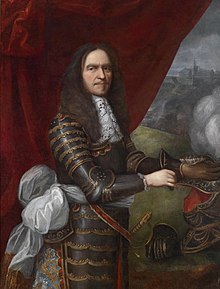Viscount
A viscount (/ˈvaɪkaʊnt/ ⓘ VY-kownt, for male[1]) or viscountess (/ˈvaɪkaʊntɪs/, for female[2]) is a title used in certain European countries for a noble of varying status.[3] During the Carolingian Empire, the kings appointed counts to administer provinces and other smaller regions, as governors and military commanders.[4] The kings strictly prevented the offices of their counts and viscounts from becoming hereditary, in order to consolidate their position and limit chance of rebellion.[7] The word viscount corresponds in the UK to the Anglo-Saxon shire reeve (root of the non-nobiliary, royal-appointed office of sheriff).Thus, early viscounts originally received their titles from the monarch, and not hereditarily; they eventually tended to establish hereditary principalities in the wider sense.The peer's heir apparent will sometimes be referred to as a viscount, if the second most senior title held by the head of the family is a viscountcy.The role of the Viscount of Jersey (French: Vicomte de Jersey) involves managing fines, bail monies, seizures, confiscations, evictions, service of process, arrests for non-appearance in court and other enforcement procedures, as well acting as coroner for sudden or unexpected deaths and managing jury selection.Thus in Dutch, Burggraaf is the rank above Baron, below Graaf (i.e., Count) in the kingdoms of the Netherlands and of Belgium (by Belgian law, its equivalents in the other official languages are Burggraf in German and vicomte in French).At the creation of the system, viscounts were the most numerous of all the ranks, with 324 being created compared to 11 non-imperial princes or dukes, 24 marquesses, 76 counts and 74 barons, for a total of 509 peers.


Viscount (disambiguation)Imperial, royal, noble,gentry and chivalric ranks in EuropeEmperor, EmpressdowagerTsar, TsarinaKaiserGreat king, Great queenHigh king, High queenconsortregnantmotherArchduke, ArchduchessGrand duke, Grand duchessPrincePrincessDuke, DuchessKnyaz, KnyaginyaHeir apparentPrince of WalesHeir presumptiveHerzogPrince-elector, Princess-electorFürst, FürstinMarquess, MarchionessMargrave, MargravineMarcher lordLandgraveCount palatineVoivodeCount, CountessEaldormanCastellanBurgrave, BurgravineVidameStarostaBaron, BaronessLord paramountOverlordTenant in chiefTerritorial lordLiege lordMesne lordLendmannNobilePrimorFidalgoBaronet, BaronetessVavasourImperial knightKnight/ChevalierRitterKnight bachelorDruzhinnikLord of the manorEsquireGentleman, GentlewomanFranklinYeomanMan at armsEdelfreiMinisterialisHenri de La Tour d'Auvergne, Viscount of TurenneEuropeanOld FrenchModern FrenchMedieval LatinaccusativeLate LatinCarolingian EmpirecountsgovernorsjudicialNormandyNormancastleBessinbailiffsprovostsBritish peerageJohn BeaumontHenry VIAnglo-Saxonshire reevesheriffher coronationQueen VictoriaPrime MinisterLord MelbourneViscount of AudenaerdeViscount of HombekeViscount de SpoelberchViscount EyskensViscount PoulletViscount FrimoutViscount De WinnePeerages in theUnited KingdomDuke / DuchessMarquess / MarchionessEarl / CountessBaron / BaronessScotlandLord / Lady of ParliamentHereditaryRepresentativeEnglandGreat BritainIrelandUnited KingdomNobilityHistoryPrivilegesCourtesy titlesForms of addressFamily seatTerritorial designationJacobiteAustraliaCanadaHouse of LordsLord of ParliamentBritish Islessecondary titlesViscount FalmouthViscount HardingeViscount Colville of CulrossViscount of Arbuthnott